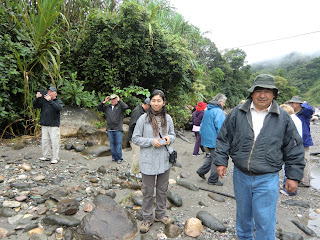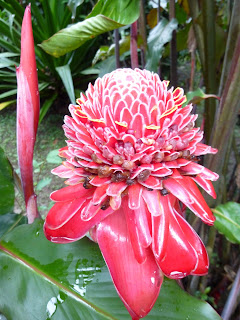We were supposed to leave at 5:00 am but the bus was on Bolivian time and didn't arrive until 5:30.

This is a picture Sister Crayk (the president's wife) took of Farron and me inside the bus - followed by a couple Farron took from our perch looking back at the rest of the missionaries.
Here are a couple of sunrise shots - in the rain - on the high plateau, as well as one little town we went through (Colomi).
This lake, also on the high plateau, is twenty-plus miles long. There is a dam at one end and we understand they do produce some hydro-electric power here. It may also be used for some irrigation; we're not sure about that. There are some trout farms in the area too.
We passed a couple of toll booths on this highway and just past the first one, we made a "potty stop". This was an experience (but not as bad as the stop we made on the way home.) Here are some pictures of the ladies' rest room area - no locks on the doors, so Diana (Crayk) is holding the door shut for one of the other ladies. Neither the toilets nor the paper are free, but 1 Boliviano buys you the use of a toilet and a fairly substantial wad of TP. Notice the big water barrel near the doors? Those are gallon jugs floating in the water. That's how you flush - you dip a gallon of water and fling it in the cubicle before (if you're smart) as well as after you use it. You can see that the cubicle I'm standing by is really quite clean. The place we stopped at going home was the same style but not anywhere near as clean.
As we headed down out of the dry mountains and into the jungle area, we began to see not only much more (and greener) vegetation alongside the road, but also the clouds resting down on the mountains. It was really beautiful.
Here too is the one shot I got of the river we crossed several times (including once in a basket - which you'll see later.) It is called - very appropriately, I thought - El Rio Espiritu Santo (Holy Ghost River). It is both wider and deeper farther down. In fact, we could see that in the rainy season it would be a very dangerous river to cross and it's also quite a danger to the low-lying areas nearby because it obviously cuts a very wide swath when it's in flood.
The first place we went when we got to Villa Tunari was Parque Nacional Carrasco.
Incidentally, I realize that hat could win a "Weird Hat" contest, but believe me, I was glad I had brought it. We brought our hats because we expected to be in the hot jungle sunshine and this hat, which covers not only most of my face but also the back of my neck, is perfect for sunny days. Of course I didn't dare take it off after being out in the rain with it the first time, because the combination of hat and humidity totally flattened my hair and I looked (and felt) like a wet rat!
There were several nice hikes from which we could have chosen, including one that went to some caves, but unfortunately, it was raining so hard, all we did was walk down to the river, find the basket that is used to cross it and ferry everyone across the river and back. Here are a few pictures of the basket experience. The one closeup is so you can see the metal cables that the basket runs on (look to the right and in back of the man standing in front of me.) The native in the last picture is the keeper of the key and the basket, and he pulls the basket across manually.
The road into the park was very narrow - so much so that the bus driver stopped a few times and got out to make sure he could negotiate the turns without the back wheels of the bus going off the road (and straight down to the river). There also was a narrow wooden bridge to cross. We were of two minds whether to get off and walk - some people did, coming back - but the bus made it both ways.
Almost forgot to mention that while we were on the other side of the river, we went down and played in the rocks for a little bit. One of the gardening staff at the Temple - Hermano Tudela - is from this area. He and his daughter were our guides. The first picture is of the two of them - then our group.
Incidentally, there are trails through the jungle on the far side of the river. One group of natives with machetes went past us. Here's a picture of Farron standing on one of the trails. (It looks like the sun is shining but don't be fooled - it wasn't. I think I had the flash on accidentally.)
After the park, we went to a place where orchids grow - except they're out of season right now - but we saw some other jungle flowers instead. Here are the pictures of the different flowers (as well as two cayman that were in a pond at this same place - a fenced pond, thankfully.)
Above, surely the world's tiniest orchid. Below, surely the world's most unfriendly tree. Those thorns are real and they are sharp!

I don't know the difference between a cayman, an alligator and a crocodile but these are caymen (I assume that's the right plural?)
From the orchid place, we went back into town and had lunch at a really nice place. It reminded me of the restaurant in Zamora, Ecuador where Vanessa, Robb, Hermano Jara, Farron and I ate. In fact, Farron was a little afraid of the similarities - he wouldn't try the fish because he got sick on the fish in Ecuador. I had it though and it was good. Here's a picture of the restaurant, including one not-so-elegant feature.
I hasten to say that only the men's restroom facilities were "open to the weather", so to speak. The ladies' facilities were both clean and private.
I forgot to mention that we did see something besides flowers while we were wandering around. There were wild papaya growing at the entrance to the park.
We also saw what our guide said was a cacao tree and this is a cacao pod (from whence comes cocoa).
We saw a coffee bean tree - I still find that hard to believe, because I've seen those Colombian coffee commercials where the guy is out in the coffee plantation and the coffee is growing on bushes - but maybe this is what they grow to be if they're out in the wild and not pruned, managed, or whatever.
We saw a lot of banana trees with fruit. Sister Crayk swears the seeds are in that long pod at the end, but I always thought the banana had seeds inside itself, so who knows. Do you? Maybe I'll do some research and find out.
Further, we saw a wild coca plant (not to be confused with cocoa or cacao). Coca is any of the four cultivated plants which belong to the family Erythroxylaceae, native to western South America. The plant is a cash crop in Argentina, Bolivia, and Peru.
All in all, we got quite a horticultural education on this trip!
After lunch we hoped to see a monkey preserve, but it turned out to be closed - not only on Mondays (which it was) but also on rainy days - so we had two strikes against us. We then tried for a turtle farm, but the people out at the end of the 1/4 mile driveway said they thought it too was closed (Monday, rain or ?) The road was narrow and we were told there was no place for the bus to turn around if we drove on in, so we elected to forego the turtles.
By this time it was almost 4:00 pm so we headed back for Cochabamba. We were all slightly (or more-than-slightly) damp and the bus - like all vehicles in South America - had no heat, so by the time we rode for 4 hours and climbed a few thousand feet to get home, we were all frozen. It felt SO good to come into our little apartment, turn on the space heater and just stand there in front of it for a while. Nevertheless and notwithstanding the hours in the bus, the rainy day, the places that were closed, and/or the public bathrooms - it was good to see all the things we saw and the trip was definitely worth it.
That's all - and more than enough - for today. Have a great week. Vayan con Dios!
















































